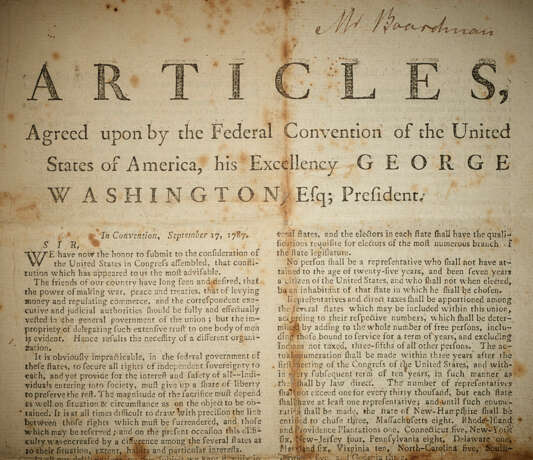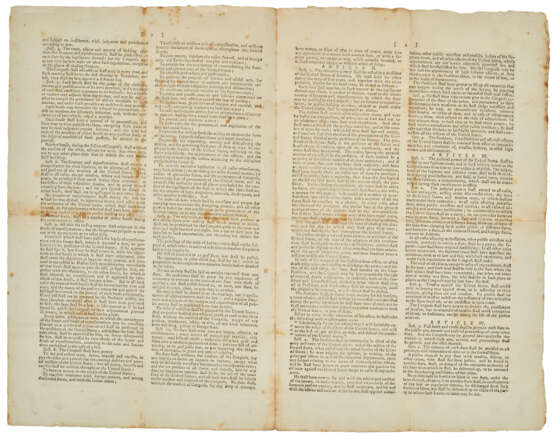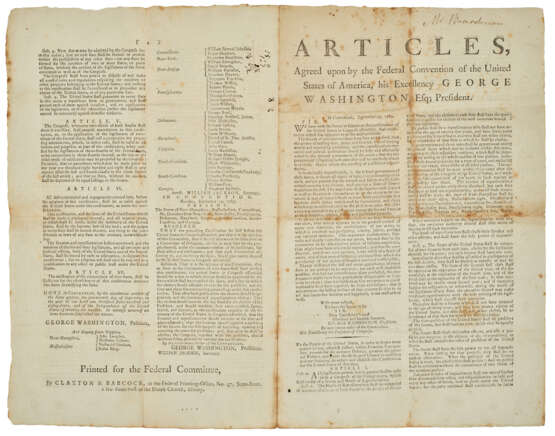ID 1119231
Lot 120 | A federalist printing of the Constitution
Valeur estimée
$ 80 000 – 120 000
The Federal Committee, Albany, circa March 1788
UNITED STATES CONSTITUTION – Articles Agreed upon by the Federal Convention of the United States of America, his Excellency George Washington, Esq; President. In Convention, September 17, 1787. Sir. We have now the honor to submit for consideration of the United States in Congress assembled, that constitution which as appeared to us the most agreeable…. We the People of the United States, in order to form a more perfect Union…. Albany: Printed for the Federal Committee by Claxton & Babcock at the Federal Printing Office, [c. March 1788].
"We, the People..." A unique, Federalist printing of the Constitution intended to promote the election of delegates favoring ratification. A previously unrecorded folio printing of the Federal Compact, intended by Albany Federalists to influence the election of delegates to New York's bitterly divided ratification convention which convened at Van Kleck's tavern in Poughkeepsie in June 1788. In this edition, the full text of the Constitution is preceded by the letter of the Constitutional Convention (signed in type by Washington), submitting the Constitution to Congress (17 September 1787) with the assurance that "the constitution which we now present, is the result of a spirit of amity," which "we hope and believe may promote the lasting welfare of that country so dear to us all, and secure her freedom and happiness." With the same date, following the certification of Washington and the enumeration of all the states' delegates, is the Convention's final resolution that the Constitution be laid before Congress and the states and implemented when nine states have ratified the Constitution, as provided in Article VIII.
To place Washington's endorsement in the title of this printing was a logical choice by the Federal Committee, a group established in Albany in March 1788 to counter a similar organization of Anti-Federalists that had coalesced the previous month. Both groups sought to influence the selection of delegates to the ratification convention (see Pauline Maier, Ratification, p. 328). In mid-March, the Committee published a slate of candidates "who wish to see Harmony an Good Government rise superior to a state of Anarchy and Confusion" ("To the Independent Electors…" The Albany Journal, 15 March 1788, p. 3). The Federal Committee also engaged Claxton and Babcock to print a Dutch language version—a testament to the persistence of the language in the upper Hudson Valley—and a sign of their determination to reach as wide an audience as possible. Babcock's imprint (at the same address, 47 State Street) appears on a Dutch-language edition of the Constitution (Artyklen, die Geaccordeerd zyn by de Foederal Conventie, Evans 20792), with the credit that it had been "Gedruckt voor de Foederale Committee." Evans assigns Babcock's Dutch printing to 1787, for unstated reasons, but there is no doubt that the present printing was executed at about the same time. For more on the battles between the Federal Committee and their Anti-Federalist rivals, see Pauline Maier, Ratification, p. 328-333.
Overall, very few New Yorkers approved of the newly drafted Constitution. Two of the state's three delegates to the Convention had walked out of the Convention and only Hamilton signed the final document. The debate over ratification was particularly acrimonious in New York. Delegates to the Convention were not even selected until April 1788, and when chosen, the majority of delegates were Anti-Federalist. But as the Albany Federal Committee warned in the 15 March issue of Journal, the Constitution had "been already RATIFIED by SIX powerful States—Four of which are our immediate neighbors". A reality that placed additional pressure to ratify. As the debates raged at the Poughkeepsie Convention, Hamilton himself paid for express riders to bring the news that New Hampshire had become the ninth state to ratify which pushed the delegates to negotiate a compromise. With the addition of a proposed Bill of Rights, New York became the 11th state to vote for ratification, on 26 July 1788. Unrecorded in Evans or Bristol.
Four pages, bifolium, 345 x 220mm, several manuscript notes on the fourth page. (Toned along a few folds, some light scattered foxing). Provenance: "Mr. Boardman" (subscriber's inscription) – Christie's New York, 22 May 2001, lot 166.
| Catégorie maison de vente aux enchères: | Lettres, documents et manuscrits |
|---|
| Catégorie maison de vente aux enchères: | Lettres, documents et manuscrits |
|---|
| Adresse de l'enchère |
CHRISTIE'S 20 Rockefeller Plaza 10020 New York Etats-Unis | ||||||||||||||
|---|---|---|---|---|---|---|---|---|---|---|---|---|---|---|---|
| Aperçu |
| ||||||||||||||
| Téléphone | +1 212 636 2000 | ||||||||||||||
| Fax | +1 212 636 4930 | ||||||||||||||
| Conditions d'utilisation | Conditions d'utilisation | ||||||||||||||
| transport |
Service postal Service de messagerie ramassage par vous-même | ||||||||||||||
| Modes de paiement |
Virement bancaire | ||||||||||||||
| Heures d'ouverture | Heures d'ouverture
|





